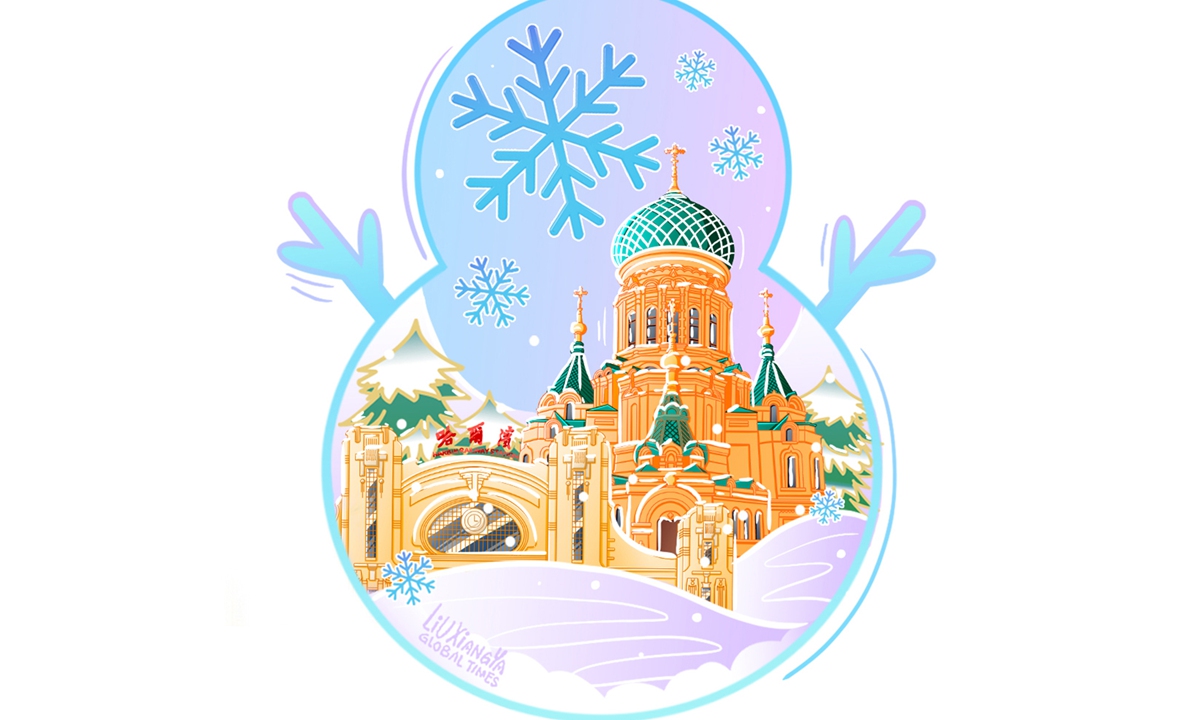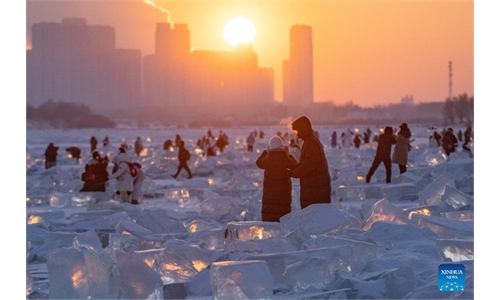ARTS / CULTURE & LEISURE
Hospitality, fairy-tale scenes beat the cold

Illustration: Liu Xiangya/Global Times
On my flight from Beijing to Harbin, there seemed to be a lot of tourists.
"Harbin was never top on my list of places to visit. I thought it was just ice and snow. But it's all over social media this winter," said a college student sitting next to me while stuffing heating pads inside her shoes.
Lush mountains and lucid waters are invaluable assets, as is ice and snow covered land. During the recent three-day New Year holidays alone, Harbin received over 3 million tourists, creating revenue of 5.9 billion yuan ($826 million). The enthusiasm of visitors from across the country toward Harbin has remained unabated.
Boosted by the Beijing 2022 Winter Olympic Games and the 9th Asian Winter Games, which will be held in Harbin in 2025, ice and snow culture has swept across China. Northeast China boasts rich winter tourism resources. Harbin, as the capital of China's northernmost province of Heilongjiang, is especially well known. Dubbed China's "ice city," Harbin's history of celebrating ice and snow culture has extended more than 60 years, with the first ice lantern exhibition held here in 1963. Recently, the Ice and Snow World was recognized by the Guinness World Records as the world's largest ice and snow park. In addition to intricate ice and snow sculptures scattered at various spots across the city, a series of fun and unique winter activities await tourists to explore.
"Snow and ice sports and culture is part of Harbin people's identity. The visitors are not only drawn here by the region's quality facilities but also Harbin's lively atmosphere, passion for ice and snow culture," said Guan Liang, general manager of Harbin Bonski, the city's largest indoor ski area.
Besides its rich winter tourism resources, local government and relevant sectors have put in great effort to advance the tourism industry by a series of proactive measurements such as strengthening management and providing better training. Analysis by domestic media attributed social media as one of the key factors that has fueled the tourism boom in Harbin, noting that it was the effusive praise from tourists and netizens that made the city an internet sensation this winter.
More importantly, the concerted efforts from ordinary residents of all walks of life have been the key player in Harbin's winter miracle.
"We are probably the first locals the tourists will interact with upon their arrival in the city. I hope to give them a good first impression of my hometown and have a good start of their journey," Xu Feng, a taxi driver, said while pulling out various presents he had prepared for tourists such as potato-shaped key chains and plush toys, as southern tourists were given the affectionate nickname "southern small potatoes."
There were also some famous local treats such as "frozen pears," smoked, garlic-flavored red sausage and even some niandoubao (sticky steamed buns stuffed with bean paste), a traditional pastry in the Northeast region that he had made himself.
"When I see some tourists wearing clothes that aren't warm enough, I will give them some recommendations about where to buy inexpensive winter wear," he added.
I went to a place Xu recommended. It was a wholesale clothing market near the Saint Sophia Cathedral, an Orthodox church which has emerged as a hot tourist spot attracting tons of tourists to dress up in costumes and pose for photos. At a place like this, customers usually need to bargain with great effort, but not this season.
"It's so great to see so many visitors this year. I don't want to hurt their feelings by charging them a higher price. I cherish my hometown's image, which has been significantly boosted by this tourism boom," said a vendor.
Outside the Museum of Evidence of War Crimes by the Japanese Army Unit 731, a local resident whose face had turned red from standing too long in the cold was greeting every visitor by handing out small Chinese national flags. Some local residents had also set up stalls to hand out hot ginger tea and heating pads. They were just warm-hearted residents who live nearby and decided to help.
At the same time, local residents in Harbin were not the only ones to write a winter fairytale about Harbin. Visitors coming from all over the country, who lined up outside the museum of Japanese war crimes on blisteringly cold days, are part of the story.
Another part of the story, different cities and regions interacted with Harbin by sending gifts back and forth, which gradually evolved into a "gift" and friendship exchange craze sweeping across the country. Various ethnic minority groups traveling to Harbin from different regions across the country also had their tale to tell.
Leading with a tourism boom in the "Ice City," they are writing a new chapter in striving for the full revitalization of Northeast China. Despite the vast land and diverse ethnic cultures of the country, this winter, the warm memory of Harbin will be shared and cherished by every corner of the nation.
The author is a reporter with the Global Times. life@globaltimes.com.cn

